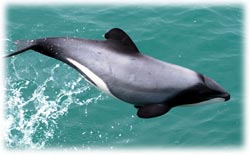|
|
| What's New?/NI Hector's Dolphin |
last updated 22 May 2002 |
|
 |
 |
| |
| URGENT: The North Island Hector's Dolphin
Needs Your Help |
|
The Minister of Fisheries and the Minister of Conservation are
in the process of deciding how to best protect the critically endangered
North Island Hector's dolphin. Please write a letter or send an
email supporting option 3 below, or stronger measures. Feel free
to use any of the arguments below to support your case.
You can send your letter to:
|
- Pete Hodgson, Minister of Fisheries, Parliament
Buildings, Wellington
- Sandra Lee, Minister of Conservation, Parliament
Buildings, Wellington
(no stamp required)
|
| |
| Or by email to: |
|
Three management options have been put forward:
- Fishing industry option
Protected area from Manukau Harbour to Aotea
Harbour. No gillnetting would be allowed on the open coast, to
4 nautical miles offshore. Acoustic "pingers" would
be used in Hector's dolphin habitat north of the protected area,
in the hope of warning the dolphins of the nets' presence (unfortunately,
there is no scientific evidence that this method works for Hector's
dolphins). An additional, seasonal closure is proposed for the
area south to Mokau for January, February and March each year,
to 2 nautical miles offshore. The total protected area in option
1 (seasonal and year-round protected areas combined) is about
half of the habitat of the North Island Hector's dolphin. This
option does not include protection for Hector's dolphins in the
harbours on the North Island west coast, nor reductions in the
amount of trawling.
- Ministry of Fisheries option
Protected area from Maunganui Bluff (near Dargaville)
to Pariokariwa Point (about 40 km north of New Plymouth) This
includes about 90% of the Hector's dolphin habitat off the West
Coast of the North Island. No gillnetting would be allowed on
the open coast out to 4 nautical miles and in the entrance of
the Manukau Harbour. This option does not include protection for
Hector's dolphins in the other harbours on the North Island west
coast, nor reductions in the amount of trawling.
- Department of Conservation option
Protected area from Maunganui Bluff to Pariokariwa
Point (same as option 2, but also includes harbours). No gillnetting
would be allowed on the open coast out to 4 nautical miles and
in parts of several of the harbours (Kaipara, Manukau, Kawhia,
Raglan, Aotea and Port Waikato). No trawling or Danish Seining
would be allowed within 2 nautical miles of the coast (trawling
is currently prohibited to 1 nmi offshore). Commercial fishers
using trawling and Danish seining between 2 and 4 nautical miles
offshore would be required to carry observers, video cameras or
other means of detecting dolphin captures.
Option 3 shows by far the best promise of protecting the North
Island Hector's dolphin. Several meetings of interested groups (Fishers,
Ministry of Fisheries, Department of Conservation, scientists, conservation
groups, etc.) have agreed that the management goal for North Island
Hector's dolphin should be to reduce human impacts to as close to
zero as possible. The DOC option is the only proposal that has any
chance of achieving this. We suggest you send a letter or email
to the Minister of Fisheries and Minister of Conservation to support
option 3 above, or stronger protection measures.
Background
Hector's dolphin is an endangered species, only found in New Zealand.
The North Island population is very small (most likely fewer than
100 individuals, Russell, 1999) and has recently been listed as
critically endangered on the international Red List of threatened
species (IUCN, 2000). North Island and South Island Hector's dolphins
are genetically different (Pichler et al., 1998).
The North Island population is declining (Martien et al.,
1999; Pichler and Baker, 2000), due to bycatch in gillnets (Martien
et al., 1999). A sustainable level of bycatch would be about
one dolphin every 5 years. A meeting of fishers, conservation groups,
scientists and government officials (in Wellington in May 2000)
agreed that bycatch should be reduced to zero, to allow the population
to recover. The only effective way to achieve this would be to avoid
overlap between dolphins and gillnets.
North Island Hector's dolphins are found between Maunganui Bluff
(north of Dargaville) and New Plymouth. To reduce bycatch of Hector's
dolphins to sustainable levels, it would be necessary to avoid gillnetting
and trawling for this whole area, out to at least 4 nautical miles
offshore.
References
|
- Dawson, S., Pichler, F., Slooten, E., Russell, K. and Baker,
C.S. 2001. North Island Hector's dolphin is vulnerable to extinction.
Marine Mammal Science 17 (2): 366-371.
- Dawson, S.M., Read, A. and Slooten, E. 1998. Pingers, porpoises
and power: Uncertainties with using pingers to reduce bycatch
of small cetaceans. Biological Conservation 84(2): 141-146.
- IUCN Red Data List 2000. IUCN, World Conservation Union, Gland,
Switzerland, www.redlist.org.
- Martien, K.K., Taylor, B.L., Slooten, E. Dawson, S.M. 1999.
A sensitivity analysis to guide research and management for Hector's
dolphin. Biological Conservation 90: 183-191.
- Pichler, F. and Baker, C.S. 2000. Loss of genetic diversity
in the endemic Hector's dolphin due to fisheries-related mortality.
Proc R. Soc. Lond. B. 267:97-102.
- Pichler, F., Baker, C.S., Dawson, S.M. & Slooten, E. 1998.
Mitochondrial differences between east and west coast populations
of Hector's dolphin. Conservation Biology. 12(3): 1-8.
- Russell, K. 1999. The North Island Hector's dolphin: a species
in need of conservation. Unpub. MSc thesis, University of Auckland.
|
|




